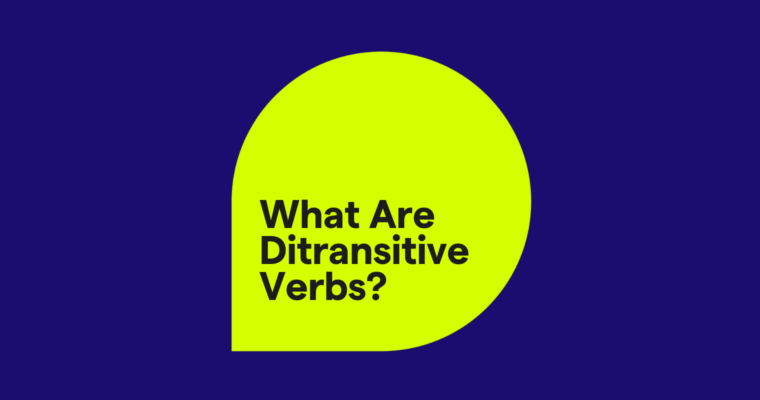
Verbs aren’t just verbs. As you know from studying the different parts of speech, just about every word in the English language fits neatly into a specific category based on its role in a sentence and, in some cases, how it interacts with other words to direct a sentence’s meaning.
A verb is a word that communicates action. Within that category, there are various subcategories, like phrasal verbs and linking verbs. Transitive verbs are verbs that must be followed by a direct object in order for the sentence’s meaning to be clear. Ditransitive verbs are a subset of transitive verbs. They are followed by both a direct object and another object or by a direct object and an object complement.
Table of contents
Ditransitive verbs vs. transitive verbs vs. intransitive verbs
Ditransitive verbs that take indirect objects
Attributive ditransitive verbs
Ditransitive verbs in the active voice and the passive voice
What is a ditransitive verb?
A ditransitive verb is a verb that takes two objects. Usually, that means the direct object and the indirect object of a sentence, but it can also mean the direct object and an object complement.
You might be wondering what it means for a verb to take an object. Translation: For the verb’s meaning (and its sentence’s meaning) to be clear, it needs to be followed by a noun or a pronoun. This noun or pronoun is the object of the sentence. Here’s one example of a ditransitive verb in action:
See how if you eliminate “her car,” the sentence doesn’t make much sense? You’re left asking, What did she sell?
Verbs aren’t the only part of speech that are categorized according to the roles specific words play in sentences. Prepositions, for example, can be divided into categories like prepositions of direction and prepositions of space. Understanding a word’s subcategory can help you understand how to construct a grammatically correct sentence.
Ditransitive verbs vs. transitive verbs vs. intransitive verbs
A ditransitive verb is a type of transitive verb. The prefix di- means “two” because, with a ditransitive verb, two objects follow the verb. A transitive verb, in contrast, takes only one object. Take a look at these examples of transitive verbs in sentences:
An intransitive verb is a verb that does not require an object for its meaning to be clear. Here are a few examples of intransitive verbs:
Whether a verb is transitive or intransitive can depend on the context in which it’s used. For example, we can rework the last example sentence to turn play into a transitive verb:
Ditransitive verbs that take indirect objects
In most cases, a ditransitive verb takes a direct object and an indirect object. As a quick reminder, here’s the difference between a verb’s direct and indirect objects:
The direct object is the noun that directly receives the action. In the sentence below, the direct object is bolded.
The indirect object is the noun that answers one of the following questions about the direct object: to whom, for whom, or for what? In the sentence below, the indirect object is bolded.
In these examples, the verb sent is a ditransitive verb because it’s followed by both a direct and an indirect object.
Attributive ditransitive verbs
When a ditransitive verb doesn’t take a direct object with an indirect object, it takes a direct object with an object complement. These are known as attributive ditransitive verbs.
An object complement is a word that describes or renames the direct object in relation to the verb. Here are a few examples of object complements in sentences with attributive ditransitive verbs:
Ditransitive verbs in the active voice and the passive voice
Ditransitive verbs can be used in the active or passive voice. In case you need a quick review: A sentence in the active voice is one where the subject does the action or acts upon the verb. A sentence in the passive voice is one where the verb acts upon the subject. Here are two examples that incorporate ditransitive verbs:
- Active voice: Damien asked Soraya a question.
- Passive voice: Soraya was asked a question by Damien.
Ditransitive verbs FAQs
What are ditransitive verbs?
A ditransitive verb is a verb that takes two objects. Usually, a ditransitive verb is followed by the direct object and indirect object of a sentence, but in some cases, it’s followed by the direct object and an object complement.
How are ditransitive verbs used with direct objects?
Ditransitive verbs communicate the action done to the direct object. For example, a sentence might read: “Jeannine gave Marco a book.” In this sentence, a book is the direct object because it’s the item being given. The ditransitive verb gave communicates that the book is being given and that Marco is its recipient.
How are ditransitive verbs used with indirect objects?
A ditransitive verb communicates an object’s entire journey, from the subject to the indirect object. When you ask “to whom, for whom, or to what?” about a sentence, the indirect object is the answer. A ditransitive verb communicates how the direct object reaches the indirect object.
What are attributive ditransitive verbs?
An attributive ditransitive verb is a verb followed by a direct object and an object complement. An object complement is a word that simply renames or describes the direct object, typically because of the action expressed by the verb.
How are ditransitive verbs different from transitive or intransitive verbs?
Ditransitive verbs are different from transitive and intransitive verbs because they require both a direct object and either an indirect object or an object complement in order to communicate their sentences’ meanings. In contrast, a transitive verb requires just a direct object, and an intransitive verb does not require any type of object to make its sentence’s meaning clear.






